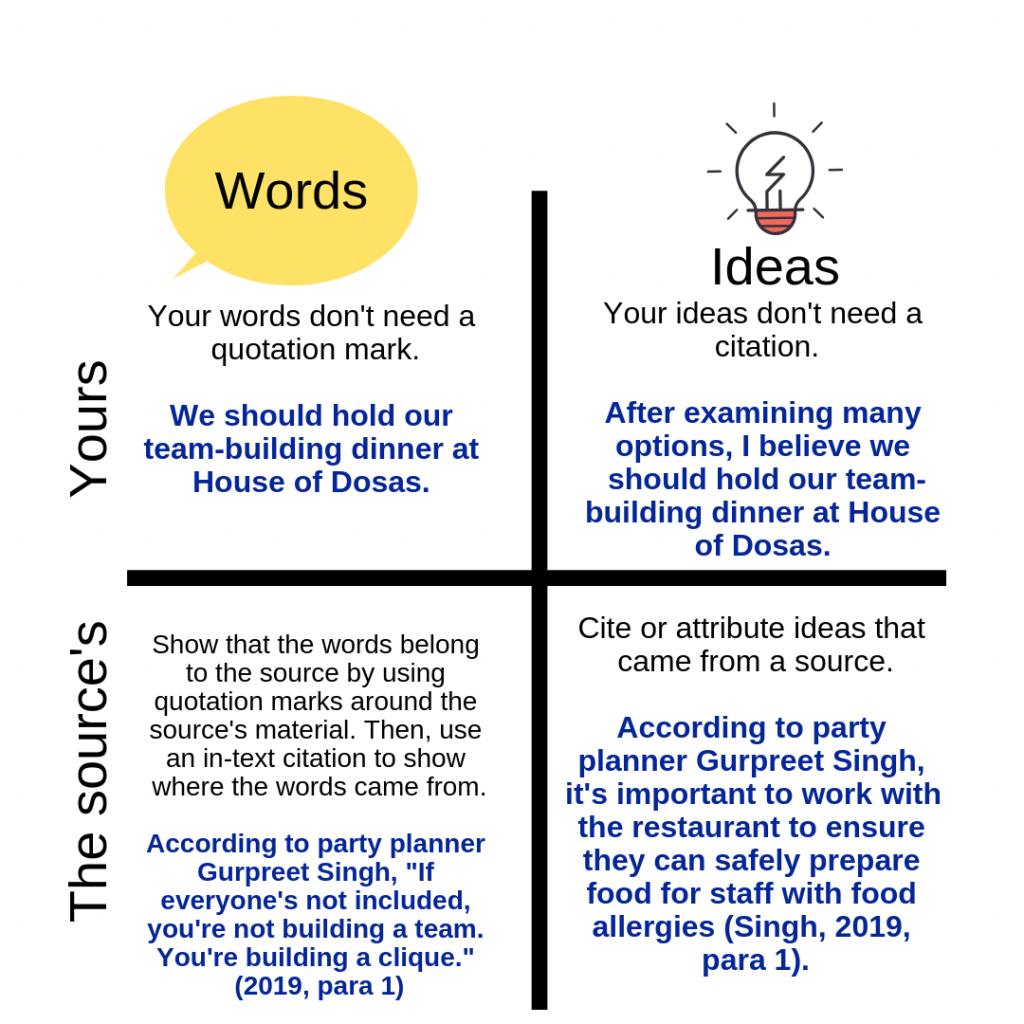11.4: How to Cite Sources
In any research paper, try to strike the right balance between information from sources and comments of your own. If you don’t use enough sources, you might struggle to make a thorough argument. If you cite too much, you won’t leave room for your own voice in your piece.
To illustrate this point, think of a lawyer arguing a case in a trial. If the lawyer just talks to the jury and does not call any (expert) witnesses, that lawyer will likely lose the case. After all, a lawyer is not an expert in forensics or accident reconstruction or Internet fraud. The lawyer also wasn’t there when the incident occurred. That’s where witnesses come in. The witnesses have knowledge that the lawyer doesn’t.
But if the lawyer just lets the witnesses talk and sits there quietly, that wouldn’t help him/ her win the case, either. That is because the lawyer is the one making the overall argument. The lawyer asks the witnesses questions and shows how the testimony of different witnesses combines and coheres to prove the case.
To cite sources, you should make two things clear:
- The difference between your words and the source’s words.
- The difference between your ideas and the source’s ideas.
This diagram illustrates the difference:

Attributing A Source’s Words
When you quote someone in your document, you are inviting another voice into your piece means that the way that person said something is important. Maybe that person is an expert and their words are a persuasive piece of evidence. Maybe you’re using the words as an example. Either way, you’ll likely do some sort of analysis on the quote.
Cite a source by using the exact words used in the source if the way the idea is phrased in that source is important (it is exceptionally clear, it provides nuance and you want to keep that, etc.). If the way the idea was expressed is not that important and you just want to convey the idea, or if you want to be brief, paraphrase or summarize.
When you use the source’s words, put quotation marks around them. This creates a visual separation between what you say and what your source says. Avoid dropping the quote into the document with no explanation. Instead, you should build a “frame” around the quote by explaining who said it and what makes it relevant. In short, you surround the other person’s voice with your own voice, giving the reader some context and providing some analytical commentary.
Example
Here’s an example of a way to integrate a quote within a paragraph.
According to Haudenosaunee writer Alicia Elliot, “We know our cultures have meaning and worth, and that culture lives and breathes inside our languages” (2019, p. 18) Here, Elliot shows that when Indigenous people have the opportunity to learn Indigenous languages, which for generations were intentionally suppressed by the Canadian government, they can connect with their culture in a new way.
Tip: The longer the source text, the more analysis you’re likely going to have to do.
As you can see, Elliot’s words are important. If you tried to paraphrase them, you’d lose some of the meaning. Elliot is also a well-known writer, so adding her voice into the document adds credibility. If you’re writing about Indigenous people, it’s also important to include the voices of Indigenous people in your work.
You can see that, in this example, the author doesn’t just “pass the microphone” to Alicia Elliot but surrounds the quote with explanatory comments — starting by mentioning who the author is and ending with a brief discussion of the meaning and relevance of what was said.
Attributing the Source’s Ideas
Elliot explains, in the same text, that when over half of Indigenous people in a community speak an Indigenous language, the suicide rate is lower (2019, p. 18). When the source’s ideas are important but you don’t think you need an exact quote, you should paraphrase or summarize, as you can see in the previous sentence.
What is paraphrasing? Paraphrasing consists of restating an idea in your own words. Let us briefly address what “in your own words” means, because many students struggle with that.
When paraphrasing, always ask yourself, “Have I restated this in a way that shows that I understand it?” If you simply replace a few words with synonyms, you haven’t shown that you understand the idea. For example, let’s go back to that Alicia Elliot quote: “We know our cultures have meaning and worth, and that culture lives and breathes inside our languages.” Let’s replace a few words and see what happens: “We know our cultures have value and importance, and that culture lives and exhales inside our languages.” Does this demonstrate our understanding of the quote? No. Elliot composed that line with precision and thoughtfulness. Making some word replacements actually shows disrespect for the care she took in her use of language. Furthermore, “exhales” is a partial synonym for “breathes” and seems awkward in that context (does culture actually “breathe out” inside our languages? does it never “breathe in,” then? and why use a more technical/ medical term?).
Instead, paraphrase by not looking at the source material. Put down the book or look away from your computer monitor, then describe the idea as if you were speaking to a friend.
Examples
Here’s another example from Alicia Elliot’s book A Mind Spread Out On the Ground. See if you can paraphrase it:
I’ve heard people say that when you learn a people’s language, you learn their culture. It tells you how they think of the world, how they experience it. That’s why translation is so difficult—you have to take one way of seeing the world and translate it to another, while still piecing the words together so they make sense. (2019, pg. 18)
Before you paraphrase it, think about what it means to you. Maybe you’ve had the experience of learning the slang or curse words in a new language and finding out what that culture sees as valuable or taboo. Maybe you’ve felt frustrated by not being able to make yourself clear in a different language. Maybe you’ve had to translate for a friend or family member, and haven’t been able to exactly capture what was said.
Now, pretend that someone asked you what Alicia Elliot said. How would you restate her words?
Maybe you wrote, “According to Alicia Elliot, it’s hard to translate from one language to another because a language is about more than just the words on a page.” Maybe you wrote, “According to Alicia Elliot, knowing another language shows how other people see the world.” Paraphrasing this way not only helps you analyze the quote, but also gives Alicia Elliot credit for her ideas. You can try to paraphrase in several different ways and see which one seems to be the best paraphrase — that is, the one that captures the idea most effectively, without altering or oversimplifying it, and without using the exact words the author used.
What’s the Difference Between Paraphrasing and Summarizing?
When you paraphrase, you take a single point within a source and restate it (as in the example above). Usually, the paraphrased version is about the same length as the original fragment. The goal of paraphrasing is usually to take someone else’s idea and restate it so that it fits the tone of whatever you’re writing. For example, you might take a complicated sentence from an academic journal and restate it so that your classmates could more easily understand it.
When you summarize, you aim to capture the main points of a larger source. Your summary will be shorter than the original source. For example, an abstract summarizes the contents of an entire report or article. You might read a book and summarize it by telling friends the main points, and your summary might be longer or shorter, depending on how much you think they need to know.
What Information Do I Cite?
Here are some guidelines to help you navigate citation practices.
 Cite when you are directly quoting. This is the easiest rule to understand. If you are stating word for word what someone else has already written, you must put quotes around those words and you must give credit to the original author. Not doing so would mean that you are letting your reader believe these words are your own and represent your own effort.
Cite when you are directly quoting. This is the easiest rule to understand. If you are stating word for word what someone else has already written, you must put quotes around those words and you must give credit to the original author. Not doing so would mean that you are letting your reader believe these words are your own and represent your own effort. Reference the source when you are summarizing and paraphrasing. Always start by mentioning the author’s name or the title (if no author is specified), and always end by providing any additional information required for the reader to easily locate what you are paraphrasing or summarizing. For paraphrases, always mention the page number if the source has page numbers (otherwise, you can mention the paragraph number). For summary statements, you don’t have to mention page numbers if, say, you are summarizing an entire book/ article in a sentence or two. However, if you summarize one or two specific pages in one of your sentences, then you should mention the page number.
Reference the source when you are summarizing and paraphrasing. Always start by mentioning the author’s name or the title (if no author is specified), and always end by providing any additional information required for the reader to easily locate what you are paraphrasing or summarizing. For paraphrases, always mention the page number if the source has page numbers (otherwise, you can mention the paragraph number). For summary statements, you don’t have to mention page numbers if, say, you are summarizing an entire book/ article in a sentence or two. However, if you summarize one or two specific pages in one of your sentences, then you should mention the page number. Reference the source when you are citing something that is highly debatable. For example, if you want to claim that an oil pipeline is necessary for economic development, you will have to contend with those who say that it produces few jobs and has a high risk of causing an oil spill that would be devastating to wildlife and tourism. To do so, you’ll need experts on your side.
Reference the source when you are citing something that is highly debatable. For example, if you want to claim that an oil pipeline is necessary for economic development, you will have to contend with those who say that it produces few jobs and has a high risk of causing an oil spill that would be devastating to wildlife and tourism. To do so, you’ll need experts on your side.When Don’t You Cite?
 Don’t cite when what you are saying is your own insight. Research involves forming opinions and insights around what you learn. You may be citing several sources that have helped you learn, but at some point you will integrate your own opinion, conclusion, or insight into the work. The fact that you are NOT citing it helps the reader understand that this portion of the work is your unique contribution, developed through your own research and critical thinking efforts.
Don’t cite when what you are saying is your own insight. Research involves forming opinions and insights around what you learn. You may be citing several sources that have helped you learn, but at some point you will integrate your own opinion, conclusion, or insight into the work. The fact that you are NOT citing it helps the reader understand that this portion of the work is your unique contribution, developed through your own research and critical thinking efforts. Don’t cite when you are stating common knowledge. What is common knowledge is sometimes difficult to discern. Generally, quick facts like historical dates or events are not cited because they are common knowledge.
Don’t cite when you are stating common knowledge. What is common knowledge is sometimes difficult to discern. Generally, quick facts like historical dates or events are not cited because they are common knowledge.
Examples of information that would not need to be cited:
- Partition in India happened on August 15th, 1947.
- Vancouver is the 8th biggest city in Canada.
However, some quick facts, such as statistics, are trickier. For example, the number of gun- related deaths per year in a specific country/ province/ state should be cited, because there are a lot of ways this number could be determined (does the number include murder only, or suicides and accidents, as well?) and there might be different numbers provided by different organizations, each with an agenda around gun laws.
One way to determine whether or not to cite facts is to see whether the same data is repeated in multiple sources. If it is not, it is best to cite.
Another aspect that makes this determination difficult might be that what seems new and insightful to you might be common knowledge to an expert in the field. You have to use your best judgment, and probably err on the side of over-citing, as you are learning to do academic research. You can seek the advice of your instructor, a writing tutor, or a librarian. Knowing what is and is not common knowledge is a practiced skill that gets easier with time, as you accumulate more knowledge and experience.
Image Description
Figure 11.4.1 image description: This chart illustrates the concept that you should use quotation marks and in-text citation to distinguish between the words of the source and your own words. You should use paraphrasing and in-text citation to distinguish between your ideas and the source’s ideas. [Return to Figure 11.4.1]
References
Elliott, Alicia. (2019). A Mind Spread Out on the Ground. Penguin Random House.

